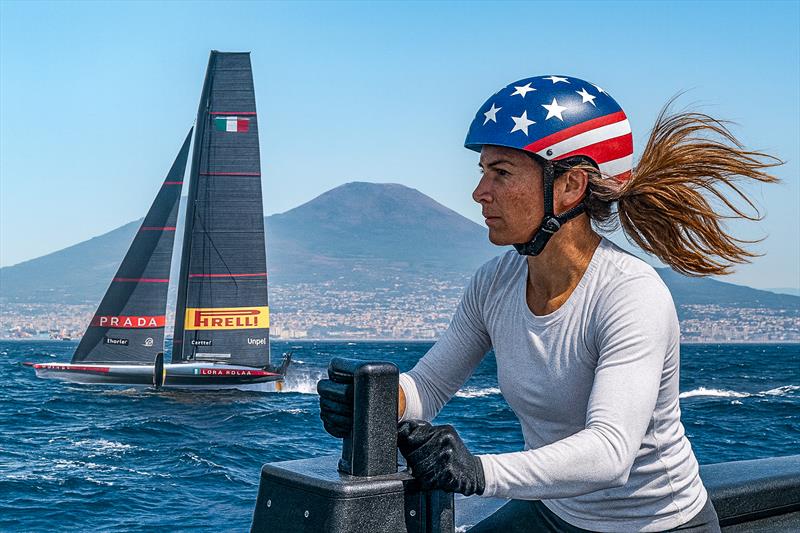
An historic moment for the America's Cup, but the real work starts now
by Victoria Low, CEO, The Magenta Project 15 Aug 04:03 BST

Women's sailing has already scored a key win in the 38th America's Cup © Sail-World.com/nz
This week’s announcement from the America's Cup felt momentous.For the first time in its 174-year history, female sailors will be mandated onboard AC75s at the pinnacle of our sport.
It’s a seismic shift in attitude and an acknowledgement that the future of sailing must be inclusive. It tells every young sailor that competing in the sport’s most iconic event is a realistic goal, not a distant dream.
But progress on paper is only the beginning. This cannot become another Instagram moment with headlines about “sparkling” or “smiling” female sailors that miss the point entirely.
Mandating female inclusion must be backed by systems that identify raw talent, prepare women to earn selection on merit, and ensure they are seen as sailors first, not “female sailors.”
The timing is significant. Just as this structural change reaches the top of the sport, we’re launching 2x25, the most ambitious equity and inclusion review ever undertaken in sailing and the wider marine industry.
This is our opportunity to track whether the promise of inclusion becomes reality, and to understand what barriers still need dismantling at every level of the sport.
Sailing Already Has The Foundations
Sailing has always had the potential to be the world’s most inclusive sport. I’ve worked in it for over 30 years and have seen it evolve dramatically. Stellar female sailors have smashed ceilings offshore, inshore, in the Olympics and now foiling.
They’ve called the tactics in mixed competition, rewritten offshore playbooks, and moved from Olympic golds to SailGP and the Women’s America’s Cup. These women, heroes in our sport, have proved that, when given the opportunity, talent rises regardless of gender.
And yet, I've sat in meetings where equally qualified women were passed over for roles because the team or organisation “preferred working with the boys.”
That contradiction is what drives me. Because unlike football, rugby, or tennis, sailing doesn’t need separate competitions to showcase talent. We already race together. We already prove that the best sailor isn’t defined by brute force but by who reads the shifts first, calls the right tactics and communicates under pressure.
The shift to foiling has only accelerated this truth. In an IMOCA, an AC75, an F50 or a Waszp, raw power means nothing without precision. The helm who can feel a two-degree shift in apparent wind beats the one who can bench press 150kg every time.
The numbers we cannot ignore
When we first undertook the Women in Sailing Strategic Review in 2019, the results were stark:
- 80% of women and 56% of men saw gender balance as an issue in sailing
- 59% of women and 14% of men had experienced gender-based discrimination
- Discrimination rates increased with age: 43% of girls (11–18), 59% of women (19–25), and 71% of women (26–30)
The data was confronting, but it drove change. Over the past six years, initiatives like World Sailing’s Steering the Course, the Women’s America’s Cup, SailGP’s Women’s Pathway and many other high-achieving all-female projects have increased visibility for women. More women are now working in engineering, boatbuilding, performance, and operations.
Yet for a sport and industry that prizes data and constant performance analysis, it’s striking that this single dataset has been our main measure of progress ever since. That’s why we launched 2x25 to build a clearer, more up-to-date picture of where we stand and where change is still needed.
Early responses show that 60% agree there are slightly more opportunities for women.
Yet they also reveal 79% still see gender balance as an issue, and 73% still experience sexist behaviour. The data tells us that while progress has been made in some areas, the underlying barriers remain.
2x25 widens the lens beyond gender to include race, age, disability and socioeconomic barriers. We’re surveying everyone: Olympic campaigners, club racers, boat builders, sail makers, race officials, media. Because inclusion isn’t just about who is on the boat. It’s about who’s designing it, calling the races, writing the rules and telling our stories.
What winning should look like
The America’s Cup’s new protocol is a powerful step towards the future we should all want. But the destination needs to be bigger.
Here's my vision. By 2030, at any major regatta, whether it's the America's Cup, SailGP, or The Ocean Race, you shouldn’t be able to tell someone's gender, race, or background from their role. You'll only see the fastest, smartest, most tactically astute sailors.
By 2035, 50% of professional sailing roles should reflect the diversity of our global community. That means:
- Coaching pathways that scout and develop talent regardless of background
- Selection criteria based purely on performance metrics, not familiarity
- Sponsor accountability that rewards genuine inclusion, not tokenism
- A pipeline so strong that diversity becomes inevitable, not intentional
This isn’t about quotas. It’s about removing invisible barriers that stop the best sailors from getting to the start line.
The Starting Gun
When sailing decided foiling was the future, it didn’t wait for committees. It built boats and went racing. When we embraced environmental responsibility and our connection to the ocean, we launched sustainable campaigns and carbon-neutral events.
Inclusion is no different. We have the tools. We have the platform. We have the crew. Now we need the course.
2x25 is that course. It's a ten-minute survey that gives us the data to make informed decisions rather than assumptions. It's backed by 11th Hour Racing and World Sailing, designed to give us the data to turn good intentions, like yesterday’s America’s Cup announcement, into measurable and lasting change.
The America’s Cup has fired the starting gun. Now it’s up to all of us to keep racing towards the finish line.
Complete the 2x25 survey by clicking here.
Results launch November 2025.